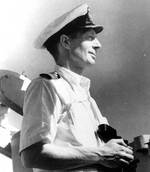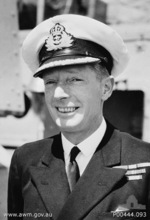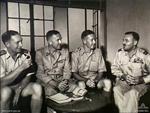John Collins
| Surname | Collins |
| Given Name | John |
| Born | 7 Jan 1899 |
| Died | 3 Sep 1989 |
| Country | Australia |
| Category | Military-Sea |
| Gender | Male |
Contributor: Morgan Bell
ww2dbaseIn Deloraine, Tasmania, in early 1899, a navy doctor passed away while he was expecting his wife to give birth to their youngest child. In the middle of dealing with the trauma of her husband's death, she gave birth to a son. The boy was named John Augustine Collins. This infant that the navy doctor's eyes never saw would develop into what his mind would never be able to grasp: a man that would become the most influential, well known RAN officer of the Second World War. The Collins family was close-knit, so young John was not raised in severe hardship after his father's passing. At the age of fourteen he joined the first intake of students at the RAN College, where he was one of several cadets to show great potential. When he was promoted to midshipman in January 1917, Collins was assigned to the British battleship HMS Canada, operating with the Grand Fleet out of Scapa Flow. He attended gunnery courses, and specialised in gunnery. He became gun control officer with the rank of sub-lieutenant on the British destroyer HMS Spencer. In 1930, at the age of 31, he married Phyllis McLachlan, at the same time he was promoted to commander. His first executive command was the Australian destroyer HMAS Stalwart. He began working as commander of the Naval Staff Plans Division of the British Admiralty. Collins' early appointments were divided almost equally between the Royal Navy and RAN, his well-balanced career giving an excellent preparation for both senior shore commands and those afloat. In 1938 Collins was appointed Liaison Officer for Sydney Harbour's 150th anniversary celebrations.
ww2dbaseImmediately before the war Collins held a joint post as the Director of Naval Intelligence, a position that he handed over to fellow classmate, Rupert Long. By the time war arrived on 3 September 1939, Collins was Assistant to the Chief of Naval Staff (ACNS), so was deeply involved in Australia's wartime preparation. In the discussions intended to decide the most economically sound method to prepare Australia navally for war, Collins opposed politicians' (as well as those of his superior, Admiral Ragnar Colvin) pet projects. These included Billy Hughes' hopes for "nests of torpedo boats" and Admiral Colvin's plan to buy a battleship from Britain. On 16 November 1939 at Freemantle he became the executive officer of the RAN's newly purchased cruiser, HMAS Sydney. Sydney continued to operate on the Australia Station, performing escort and patrol duties. The long, often frustrating months at sea would contrast with the atmosphere they were about to enter, whilst on patrol, Collins received an order to travel to the Mediterranean via Colombo and Aden. HMAS Sydney joined the British Mediterranean Fleet in Alexandria on 24 May 1940, remaining in the Mediterranean until January 1941. Operating in the Mediterranean was a very different experience to what Collins had been used to previously, any given moment could be a state of heightened alert. Collins was a moral man; even in this atmosphere he managed a humane act without compromising his country's commitment to the British cause: early after arriving in the Mediterranean, Collins ordered Sydney to engage the Italian destroyer Espero, which was sunk, with a number of survivors from her being left in the surrounding water with no immediate source of rescue apparent. The survivors of Espero, however, did not account for the honour of the officer commanding the enemy cruiser that just sunk their vessel. Collins ordered Sydney, under potential risk of attack from Italian submarine, to stop to pick up Italian survivors. In July 1940 Collins commanded HMAS Sydney and five British destroyers to engage two Italian cruisers near Cape Spada off the coast of Crete without knowing their armament. Collins' CinC in Alexandria, Admiral Andrew Cunningham, heard a radio signal that Collins' force were "approaching the enemy", so was nervously awaiting the outcome of the Cape Spada action, as it became known. The risk Collins took proved well-judged, each of the Italian cruisers possessed equivalent armament to Sydney, but were faster than the Australian cruiser. Collins' gunnery expertise allowed HMAS Sydney to destroy Bartolomeo Calleoni and damage Giovanni Delle Bande Nere, which managed to limp away. In a report highlighting the importance of the Cape Spada action, Admiral Cunningham wrote:
ww2dbaseAlthough the action sealed his naval reputation, that of HMAS Sydney, and that of the RAN in the Second World War, both at home and within the British Commonwealth, the Cape Spada action was merely a highlight of HMAS Sydney's service in the Mediterranean, not representing its entirety. Anti-aircraft guard duty in Alexandria was a frequent task which Sydney had to perform, while fulfilling this task, Collins came under the first air attack he had faced. It was not to be his last, there would be more before the war was over. HMAS Sydney's tenure in the Mediterranean over, Collins ordered a course set for home, eventually arriving to a heroes welcome in Sydney Harbour in February 1941, remaining operating on the Australia Station for three months. After a replacement to command HMAS Sydney was found, Collins took Admiral Colvin and a small staff to an imperial conference in Singapore. Collins was unimpressed with the naval preparations on the island. Then it was decided that he would be Australian naval representative to Vice Admiral Geoffery Layton, CinC, China, at Singapore. Collins had been transferred from a theatre of the conflict, the Mediterranean, where all naval units were, at any given moment, in a state of almost constant vigilance, to the Pacific, where most officers were unaware of Japanese intentions, his warnings about the threat Japan posed fell on deaf ears in the illusion of security provided by the Singapore fortress. While in Singapore, Collins worked on Plans for the Employment of Naval and Air Forces of Associated Powers (PLENAPS), which involved a high degree of cooperation between the nations soon to become Allies in the Pacific war. The nations involved agreed with the ideas espoused in PLENAPS. However, it was predicted upon the arrival of a relief force arriving from Europe in ninety days. By the time Japan's bid to gain an empire in South East Asia was underway, PLENAPS was in operation. Collins got on well with Admiral Layton, who was relieved by Admiral Phillips immediately prior to Japan's entry into the war. Phillips' staff, however, did not take PLENAPS sufficiently seriously. Collins was in the War Room when the Japanese torpedo bombers began their attacks on the HMS Prince of Wales and HMS Repulse, after learning of their wounding, he desperately attempted to organise tug boats to drag them back to the repair dock. Like the rest of the world, he was shocked at the news of the capital ships' sinking, resulting in the death of Admiral Phillips. In light of Layton's replacement, he had boarded the merchant vessel Dominion Monarch, bound for the UK. It was left to Collins to go aboard to tell Layton of Phillips' loss. Layton returned to the War Room, in command of a number of antiquated ships to resist a victorious, professional Imperial Japanese Navy in the waters surrounding Singapore Island. Knowing Singapore was lost, Collins sent his wife and daughter to Java by sea, then onto Australia by air. Layton appointed Collins in charge of China Force, command of an assortment of British and Australian warships assisting the Allied cause in the Netherlands East Indies. The command posed a number of difficulties. The tactical command within the newly-formed ABDA area was plagued with difficulties: the ABDA area was a loosely bound command consisting of four different nationalities that was formed by agreement on the opposite side of the globe; even Collins' diplomatic skills were tested in relations with three nationalities other than his own; dealing with a NEI civilian administration concerned about family under the reality of a Nazi occupation in their home county, and the probability of a successful Japanese invasion of the colony in which they and their children currently resided, was problematic. Considering the geopolitical problems, it is not surprising that Collins had to make several difficult decisions. He ordered HMAS Perth and USS Houston to the Sunda Strait, where they subsequently met their fate. When it became evident that the headquarters in Batavia would fall, Collins withdrew to Tjilatjap on the south coast of Java, then travelling to Freemantle in the corvette HMAS Burnie. For his service in the NEI, Queen Wilhelmina of the Netherlands awarded Collins the Order of Oranje Nassau. Despite being awarded this honour, Collins' time in command of the China Force completely exhausted him. On orders of the Navy Office, Collins was appointed to the posts of Commodore-in-Charge of Freemantle and Senior Naval Officer of Western Australia (SNOWA), his family was reunited with him for the first time since they had left Singapore. Collins was given a choice: either a senior staff position in the prospective British Eastern Fleet; remain as commodore (2nd class); or become post captain for the newly acquired cruiser Shropshire. Collins enthusiastically chose the latter option. Shropshire was a gift from the British government to Australia intended to replace the loss of HMAS Canberra sustained in the Battle of Savo Island. Without hesitation, Collins flew across the Pacific to the United States, travelled by sea onto Chatham in Britain to commission the newly acquired vessel into the RAN, then commanded the ship through a course bound for Australia. His time on HMAS Shropshire was reinvigorating after his stressful time in command of China Force. Upon return home, HMAS Shropshire under Collins' command joined the Australian Squadron under Rear Admiral Crutchley. In the months to come, the Australian Squadron supported landing operations and providing gunfire support against entrenched positions and key installations. In May 1944, Collins relinquished command of HMAS Shropshire. In the following month, Collins was promoted to the rank of commodore (1st class) and the position of Commodore Commanding the Australian Squadron. While the Australian Squadron was operating as part of the 7th Fleet in the Philippines, Collins' pendant flew above the heavy cruiser, HMAS Australia. Collins was rarely absent from the bridge of HMAS Australia, and towards the conclusion of operations around Leyte the strain upon him became increasingly apparent. An attack by a Japanese kamikaze pilot upon the bridge of HMAS Australia on 21 October 1944 caused numerous casualties, including Collins himself, who was knocked unconscious and suffered extensive injury. He was evacuated to Australia, the United States Navy awarded him the Legion of Merit in honour of his service in Leyte. It was not until the following April that he was fit enough to resume the post of SNOWA. Here his family had remained since Collins had finished his first tenure as SNOWA. In July he returned to the post of CCAS, this time with HMAS Shropshire as his flagship. Further hostile operations were overtaken by the Japanese surrender. Collins took the Australian Squadron to Japan, and was the RAN representative on the USS Missouri to witness the signing of the surrender in Tokyo Bay.
ww2dbaseCollins remained CCAS until November 1946, in which time demobilisation saw the rapid reduction of naval strength and the liberation of POW camps in South East Asia saw the repatriation of Australian prisoners of war. In February 1948 Collins became Chief of Naval Staff (CNS) and First Naval Member of the Australian Naval Board. It is difficult for historians to assess the contribution of any peacetime CNS while viewing the raw historical data from a distance, but the schemes implemented to develop the RAN during Collins' tenure as CNS ensured the RAN was capable of offering a meaningful contribution to the Korean War and Malayan Emergency: the RAN Air Arm was established in the face of significant government opposition; four Daring class destroyers and four River class frigates were purchased. Upon Collins' appointment to the posts at the top of the naval profession in Australia there were no questions concerning his ability to perform in the role, yet Collins himself feared he was too junior at 49 years of age, out of a concern that he would need to retire before the statutory age of sixty. He was assured that he would be compensated for this. In May 1950 he was promoted to the rank of vice admiral. He was knighted as a Knight Commander of the Order of the British Empire (KBE) in the 1951 New Year Honours. In 1955 he retired from the RAN, which he had given so many years of faithful service during and around the Second World War. The year after he retired, Collins became Australian High Commissioner to New Zealand, a post he held until 1962. He excelled in the role, the diplomatic skills acquired over his career serving Australia well in that post. Upon Collins' return to Australia, Prime Minister Robert Menzies considered appointing him governor-general, but Collins refused the offer.
ww2dbaseCollins passed away on 3 September 1989 in Sydney, aged ninety. A submarine bearing his name, HMAS Collins, was launched by his widow in 1993, subsequently lending his name to an entire class of submarines, the ill-fated Collins class.
ww2dbaseSource: Australian War Memorial, D. Stevens (ed.), The Royal Australian Navy in World War II, Wikipedia, Royal Australian Navy.
Last Major Revision: Mar 2009
Photographs
 |  |  |
John Collins Timeline
| 7 Jan 1899 | John Collins was born. |
| 3 Sep 1989 | John Collins passed away. |
Did you enjoy this article or find this article helpful? If so, please consider supporting us on Patreon. Even $1 per month will go a long way! Thank you. Share this article with your friends: Stay updated with WW2DB: |
» Japan's Surrender
Ship(s) Served:
» Australia
» Sydney
- » 1,150 biographies
- » 337 events
- » 43,917 timeline entries
- » 1,241 ships
- » 350 aircraft models
- » 207 vehicle models
- » 375 weapon models
- » 123 historical documents
- » 260 facilities
- » 470 book reviews
- » 28,546 photos
- » 432 maps
Chiang Kaishek, 31 Jul 1937
Please consider supporting us on Patreon. Even $1 a month will go a long way. Thank you!
Or, please support us by purchasing some WW2DB merchandise at TeeSpring, Thank you!